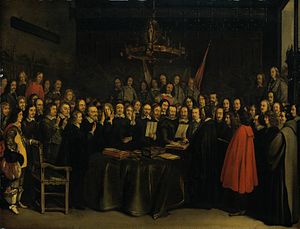The Atlantic Council’s Barry Pavel has an interesting column over at Defense News where he lays out the case that international relations has entered an era that is no longer accurately described by the assumptions about sovereignty laid out by the 1648 Peace of Westphalia. He writes that the Westphalian model is incomplete because “nation-states are joined on the global stage by powerful individuals, groups and others who can and are taking actions that are disrupting the traditional world order.” He adds that “while these actors have operated for some time, their ability to effect decisive global and regional change is about to grow exponentially.” Pavel suggests we call this phenomenon the “Westphalian-plus global landscape.”
While reading Pavel’s argument, I couldn’t help but notice that while the world at large — particularly the West — may have moved on from the Westphalian model, one major state continues to abide by several Westphalian assumptions: China. Pavel’s argument accounts for the explosion in democratic protests and populist movements worldwide, best encapsulated by the “Arab Spring” which gripped the Middle-East and North Africa (Pavel notes Venezuela and other examples as well). While this sort of “people power” may be driving events in regions important to the United States, very little can be said about the impact of these forces on how China, the world’s most populous nation and the rising power du jour, positions itself on the world stage and interacts with other nations.
Despite China’s remarkable growth, both in absolute and per capita GDP, it remains a highly dirigisme centralized oligarchy. In fact, traditional Westphalian notions of sovereignty not only describe the manner in which China operates on the international stage but also describe what is widely seen as the Chinese view of international affairs. The overarching principle of Westphalian sovereignty is that sovereignty begins and ends with the state — no external actor or institution can undermine domestic structures. Under this principle, the Westphalian model also ascribes legal equality between states and bars states from intervening in the internal affairs of another state.
We see Westphalian ideas embedded deeply in the thought underlying China’s approach to international affairs. For example, the Five Principles of Peaceful Coexistence, which China continues to adhere to, at least in name, lift Westphalian concepts almost verbatim. In particular, contemporary Chinese sensitivity to the principles of territorial integrity and non-intervention in the affairs of other states highlights the importance of Westphalian values to China’s leaders. Furthermore, the power of the individual and of private enterprise in deciding the trajectory of Chinese national interests or state policy is still highly limited. China continues to be dominated by state-owned enterprises and free thought and expression remain highly stifled. National interests and national policy, in effect, begin and end with the Chinese state.
The Westphalian model certainly has its limitations — both as a system in itself and in its ability to accurately describe the current state of the international system. In particular, as Javier Solana noted in 1998, the Westphalian model is inhospitable to international law and norms that are valued widely today in the West, such as democracy and human rights. The post-1945 world order set up by the United States and other Western powers has undermined Westphalian sovereignty in many ways, leading to several leaders and thinkers declaring its demise at various points. However, not everyone wants to see Westphalian sovereignty evaporate so quickly. I don’t dispute Pavel’s core argument — that the world has moved past the Westphalian rubric at large — but I do think that it is worth noting that a major power has resisted that paradigm shift in the international system and will continue to do so for the foreseeable future.

































